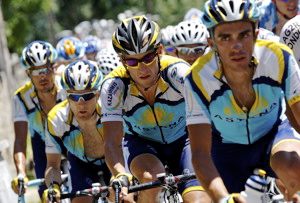JackJumpers' NBL title was special - but where does it sit among Tasmania’s top ten sporting moments?
It’s a pretty good time to be a Tasmanian sports fan right now. After years in the sporting wilderness with not much to celebrate,…

Astana teammates Andreas Kloden of Germany, American Levi Leipheimer, American seven-time Tour de France winner Lance Armstrong, and Alberto Contador of Spain, from left to right, climb towards Col de Port , France, during the 8th stage of the Tour de France (AP Photo/Christophe Ena)
In the past week the Tour de France has seen the tragic death of a female spectator, riders shot at and hurt by teenagers wielding air guns, the step back in time with the banning of race radios and the craziness and enthusiasm of the thousands of fans who line the streets within touching distance of the stars. It’s the antithesis of modern sport.
So much of sport today is sanitised.
Grounds look the same, crowds are drowned out by the silence of the suits and fans are kept at arms length.
Everything is so regimented and predictable.
Road race cycling, especially the Tour de France, counters this in every way.
The open roads allow the fans to follow the action like few other sporting codes allow.
It makes for such a unique and special event. It also adds much to the experience of following the race on television.
But the tragic death of the 61 year-old local, killed when struck by a police motorcycle preceding Stage 14, reinforces the dangers associated with such freedoms.
What is surprising is that there aren’t more problems in the chaos and cacophony of the travelling show with the racing peloton, support vehicles, motorbikes and media all trying to wind their way through a mass of people in the countryside and back alleys of France.
Incidents happen. Who can forget the cameramen, dogs, handbags and over enthusiastic fans who have unwillingly become embroiled in the drama of the race.
Having covered the Tour Down Under at the start of this year in Adelaide, I was amazed by the proximity of the crowd to the action and the endless possibility for disaster.
It’s organised chaos and some how, for the most part at least, it works.
Being so close to the riders, being able to see the anguish on their face, makes for a unique spectator experience.
It’s one of the many reasons why the Tour has stood the test of time and has become as popular as ever in its second century of racing.
As Le Tour approaches its concluding mountain stages, the intensity only rises on the climbs that will decide the race.
The scene is now set for the climactic stages and the answers that we have waited for.
Is this Alberto Contador’s race to lose? Does Lance Armstrong have the legs to push his younger teammate? What can Cadel Evans do to break Astana’s stranglehold on the race?
With the penultimate stage being, arguably, the hardest climb of the Tour, up Mont Ventoux, is there a possibility for a surprise packet to emerge on that crucial stage and steal the yellow jersey before heading to Paris and the top of the podium?
The talk that this Tour has been boring thus far isn’t necessarily true. In fact it has more to do with the heightened expectations on this year’s race with so many question marks and talking points, not to mention the early teases of drama from Armstrong, Evans and Contador.
There is much drama to be played out in this concluding week and it’ll make for spectacular viewing.